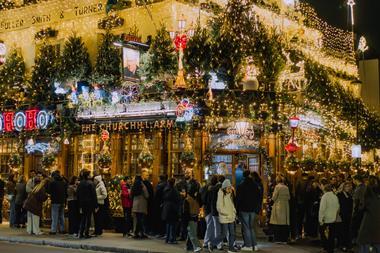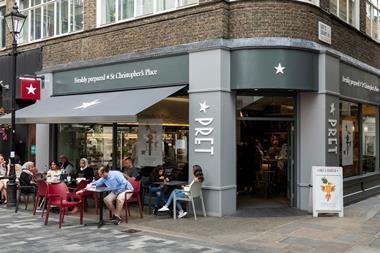There’s no denying a growing numbers of voices are raising concerns about the spectre of financial instability threatening to stall the UK’s hospitality sector. But MCA’s Steve Gotham says too much credence is being given to the doom mongers and argues that there’s plenty to be optimistic about as well:
I’ll be honest, I’m getting concerned about a creeping negativity dressed up as cautiousness. Increasingly, there appears to be a growing band of assorted industry operators, analysts and commentators jumping on the downbeat-outlook wagon for 2016. Well frankly, enough is enough, and it’s time to redress the balance and focus more on the potentially virtuous circle of bene-ficially reinforcing factors.
This is not about being stubbornly optimistic. I can’t deny the global economic backcloth, with the BRIC countries no longer the economic growth drivers they once were, and how this is having an impact on stock valuations across the western world. And yes, there is additional uncertainty from a possible Brexit, weakening sterling and higher inflation. And there are always possible interest rate rises (though less likely now this year), increasing security concerns, with terrorist threats more likely, and a probable return to rising unemployment with higher labour costs.
And closer to home, gloomier merchants do highlight:
● concerns with the introduction of the national living wage (NLW) impacting profit margins and resulting in certain corner cutting as well as higher menu prices and reduced consumer demand;
● growing challenges with the rise and rise of new competition advancing local saturation and impacting operators’ abilities to grow sales;
● increasing delivery operations cannibalising in-store sales and reducing spending levels.
After that lot you might be forgiven for thinking we are teetering on the edge of another recession and wondering about easier paths outside foodservice to earn a crust. But hang on, let’s not be too hasty and write off 2016, but apply some rather more balanced perspective.
Let’s start the case for the defence with the consumer. When we look at the demandside there are three fundamental metrics we focus upon: participation, visit frequency and average spend. What is evident, despite some quarterly volatility, is an underlying upswing, or gathering momentum in consumers eating out activity.
Eating out is entering a sweeter spot in consumers’ leisure pursuits. Foremost within the driving force behind increasing visits is the millennial generation (18 to 30-year-olds), for whom ‘gastro-tourism’ has become a key pursuit. Their keenness to try recommended new concepts and cuisines might restrict their loyalty, but they are on missions to expand their eating out horizons. Eating out has become the new going out for this influential group of foodies.
In fairness, the question might reasonably be asked about whether participation and frequency levels have peaked? In response, it is possible to look at longer term, say 40 to 50-year-old, consumer behaviour changes that highlight the non-deniable trend towards greater eating-out activity with rising per capita affluence. And it is always possible to draw a comparison with the higher eating-out activity levels in the much trumpeted North American market. In truth, this question is difficult to answer. But, what I think it is fair to say is that rising market supply with outlet growth will continue to widen consumer choice and stimulate interest, and that this will be felt most strongly in the regions, where branded operators are increasingly operating and where consumers’ visit frequencies and average spends remain some way behind those seen in London. So a reduction in differentials can be expected and are not to be under-estimated in the light of growing regional investment with signs of over-heating in the London property market.
When we look at consumer spending there is some clear encouragement from existing regional disparities. Analysis of spend differentials at dinner reveals that seven UK regions, including the north-west, West Midlands and Yorkshire, have an average per capita spend at least 10% lower than is the case in London. Even within the afflu-
ent south-east, the differential is 8%. I am not saying these differentials are going to disappear, but some diminution can be expected. This assertion is strengthened by many of the benefits of the introduction of the NLW being more strongly felt in the regions than in the capital owing to the greater uplifts that will be seen. And while we are on the subject of pay, the point is worth making that the circa 1% to 2% increases seen in recent periods will be comfortably surpassed for many by the NLW uplifts, which will boost confidence levels.
Moving the focus from the consumer to the operator, the point has to made that it is important not to get too wrapped up with the faltering performances of certain headline-grabbling chains. Some ‘wobbles’ have been evident at the likes of Frankie & Benny’s and for a longer period at certain brands within the M&B and Whitbread stables. However, the market is highly fragmented and there are several small, but more dynamic operators that are trading impressively and for which continuing out-performance and at least mid-single digit like-for-likes are pretty much racing certs. Within the café segment, Pret A Manger, Boston Tea Party and Coffee#1, will all do the business. In contemporary fast food, Barburrito, Itsu and Leon are all faring well. In the casual space, look no further than Bella Italia, Wagamama and Wahaca. In pubs, there will be further good cheer among the likes of Fuller’s, Oakman Inns and Young’s, but again, this is just an abbreviated assortment from a longer list. Importantly, these performances all add up and should in no way be overlooked.
So I would suggest there are several reasons to not get too down-trodden. Furthermore, our outlook surveys with both consumers and operators consistently point to an overall expectation of increased eating out over the next few years.
But to finish, and for all those doggedly half-empty subscribers, please don’t just take my word for it. Leading economist Alan Clarke from Scotiabank recently argued: “I think we will all look back on this last year and think, ‘why were we so downbeat when we had it so good?’” Just maybe, we might both be proved right. Cheers!
■ A market research expert in the world of hospitality, Steve Gotham is director of insight at MCA










































